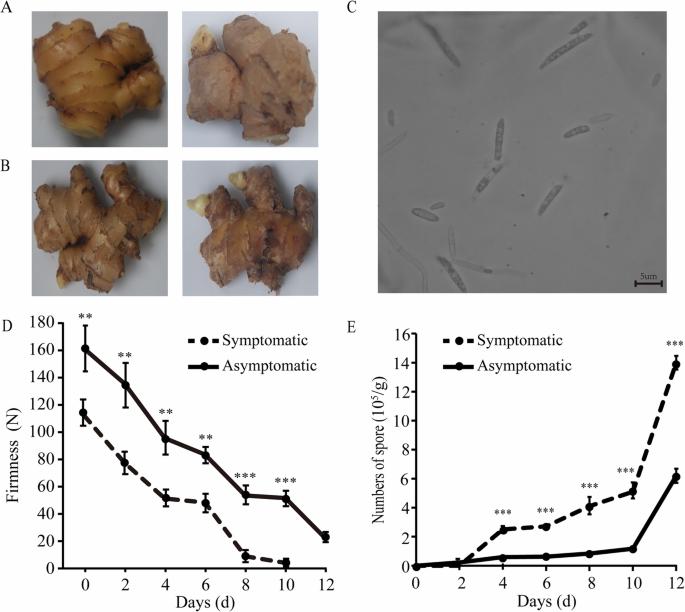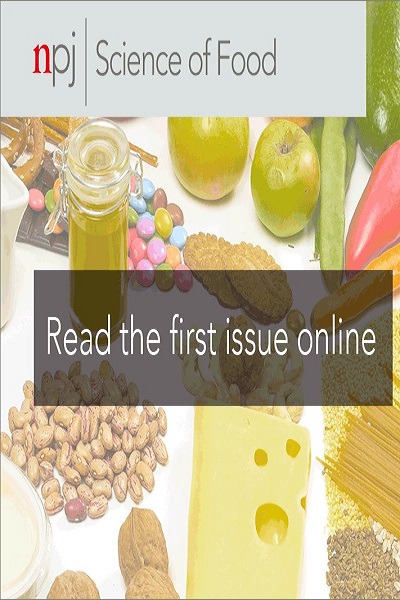镰刀菌是生姜(Zingiber officinale Roscoe)枯萎病的潜在致病真菌。
IF 6.3
1区 农林科学
Q1 FOOD SCIENCE & TECHNOLOGY
引用次数: 0
摘要
由多种镰刀菌引起的生姜枯萎病危害着这种珍贵作物的种植。然而,生姜枯萎病的致病机制和流行病学仍然难以捉摸。在此,我们研究了生姜根茎健康与镰刀菌分生孢子流行之间的关系,并考察了有症状和无症状生姜组织中的真菌群落组成。我们的研究结果表明,有病的根茎组织坚硬度降低,与镰刀菌分生孢子数量呈负相关。致病性试验证实,氧孢镰刀菌和茄镰刀菌都能诱导根茎和不育秧苗出现枯萎病症状。此外,真菌群落分析表明,镰刀菌是所有样本中的优势类群,但其相对丰度在有症状和无症状组织中存在显著差异。特别是,在有症状的地上部分,镰刀菌扩增子序列变体(ASV)的发生率更高。我们的研究结果明确指出 F. oxysporum 或 F. solani 是导致生姜枯萎病的病原菌,并证明镰刀菌是与该病相关的主要真菌病原体。这些发现为生姜行业有效的病害管理方法提供了重要的启示。本文章由计算机程序翻译,如有差异,请以英文原文为准。

Fusarium as potential pathogenic fungus of Ginger (Zingiber officinale Roscoe) wilt disease
The wilt disease of ginger, caused by various Fusarium species, imperils the cultivation of this valuable crop. However, the pathogenic mechanisms and epidemiology of ginger wilt remain elusive. Here, we investigate the association between ginger rhizome health and the prevalence of Fusarium conidia, as well as examine fungal community composition in symptomatic and asymptomatic ginger tissues. Our findings show that diseased rhizomes have reduced tissue firmness, correlating negatively with Fusarium conidia counts. Pathogenicity assays confirmed that both Fusarium oxysporum and Fusarium solani are capable of inducing wilt symptoms in rhizomes and sterile seedlings. Furthermore, Fungal community profiling revealed Fusarium to be the dominant taxon across all samples, yet its relative abundance was significantly different between symptomatic and asymptomatic tissues. Specifically, there is a higher incidence of Fusarium amplicon sequence variants (ASVs) in symptomatic above-ground parts. Our results unequivocally implicate F. oxysporum or F. solani as the etiological agents responsible for ginger wilt and demonstrate that Fusarium is the principal fungal pathogen associated with this disease. These findings provide critical insights for efficacious disease management practices within the ginger industry.
求助全文
通过发布文献求助,成功后即可免费获取论文全文。
去求助
来源期刊

NPJ Science of Food
FOOD SCIENCE & TECHNOLOGY-
CiteScore
7.50
自引率
1.60%
发文量
53
期刊介绍:
npj Science of Food is an online-only and open access journal publishes high-quality, high-impact papers related to food safety, security, integrated production, processing and packaging, the changes and interactions of food components, and the influence on health and wellness properties of food. The journal will support fundamental studies that advance the science of food beyond the classic focus on processing, thereby addressing basic inquiries around food from the public and industry. It will also support research that might result in innovation of technologies and products that are public-friendly while promoting the United Nations sustainable development goals.
 求助内容:
求助内容: 应助结果提醒方式:
应助结果提醒方式:


